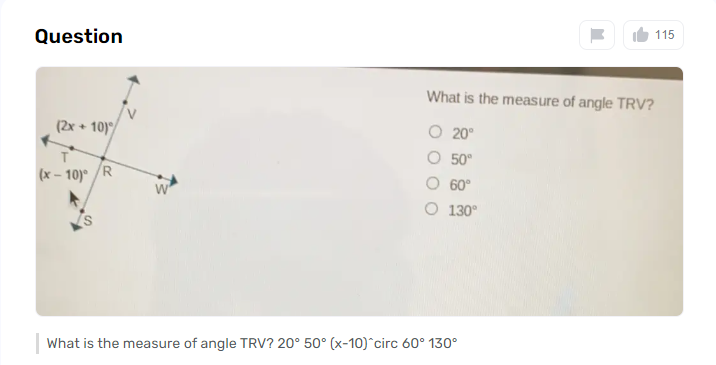Have you ever looked at two lines that came together and wondered how to measure the angles they formed? Understanding angles in intersecting lines is an essential idea in the calculation that can assist us with dissecting various shapes and figures. By knowing how to find the measure of these angles, we can open a more profound comprehension of the connections among lines and angles.
In this article, we will investigate various strategies for tracking down measures of angels in intersecting lines. From understanding substitute inside angles to recognizing vertical angles, we will dig into the different strategies that will assist you with precisely deciding the proportion of angles in crossing lines. Toward the finish of this article, you will have complete knowledge of what is the measure of angle trv? 20° 50° 60° 130° and how to dissect crossing lines.
What are Intersecting Lines and Angles?
Intersecting lines will be lines that cross each other at a solitary point. At the point when two lines intersect, they structure angles where they meet. The term “intersecting angles” refers to these angles. Vertical angles, adjacent angles, corresponding angles, and alternate interior angles are the four main types of intersecting angles.
Vertical angles are shaped when two lines meet. They are inverse angles that have a similar measure. These angles are consistently compatible, meaning they have a similar point estimation. Angles that do not overlap but share a common side and vertex are called adjacent angles. On one side of the intersection of the two lines, they are formed.
Steps to Find Measure of Angle
With regards to finding the proportions of angles in intersecting lines, there are a few stages that you can follow to settle for these angles effectively. In this part, we will frame the cycle in four moves to make it simple for you to comprehend and apply when confronted with a comparative issue.
Step 1: Identify Vertical Angles
The most vital phase in finding the proportion of a point in meeting lines is to recognize the upward angles. The opposite angles that have a common vertex at the point where two lines meet are called vertical angles. These angles are dependably consistent, meaning they have a similar measure. You can quickly determine the angle’s measurement by recognizing and utilizing the property of vertical angles.
Step 2: Using Angles Formed by Parallel Line
As we move on to the second step, you can also use the angles created by parallel lines to measure the angles formed by intersecting lines. Alternate interior angles, corresponding interior angles, and consecutive interior angles are created when a transversal line intersects two parallel lines. You can use the specific relationships in these angle pairs to find the measure of an unknown angle.
Step 3: Applying the Angle Sum Property
The sum of the interior angles of a triangle is always 180 degrees, according to this property. Equations can be constructed and the measurement of the unknown angle can be determined by applying this property to the angles created by intersecting lines.
Step 4: Solving for the Measure of Angle TRV
At long last, to decide the proportion of a particular point in intersecting lines, for example, point TRV in our model, you can utilize the data assembled from past advances. You can set up conditions in view of the properties of vertical angles, angles shaped by equal lines, and the point aggregate property to address the proportion of point TRV.
How to Use the Online Gauth AI Tool?
Using an online tool like Gauth AI can make the process of finding the measure of angles in intersecting lines much simpler for you. How to use Gauth AI to solve your problems with angle measurement is as follows:

Step 1. Open Gauth
Open the online Gauth AI tool on your device first. You can get to the device through an internet browser on your PC, tablet, or cell phone. You will be ready to enter your question and receive a response once the tool is open.
Step 2. Input the Query
Then, input the query or issue you are attempting to address with respect to the proportion of angles in crossing lines. The tool will provide you with an accurate solution if you type out the particulars of the angles and lines involved as well as any other relevant information.
Step 3. Get Results
Based on the data provided, Gauth AI will process the information you have entered and calculate the measure of the angles in the intersecting lines. It will give you a response that shows the specific estimation of each point in the meeting lines.
Summary
A methodical approach necessitates determining angle relationships, utilizing angle properties, formulating equations, and resolving for unknown angles in order to determine the measure of angles at intersections of lines. You can confidently navigate the process and successfully determine the measure of angles in intersecting lines by following the steps in this section.

